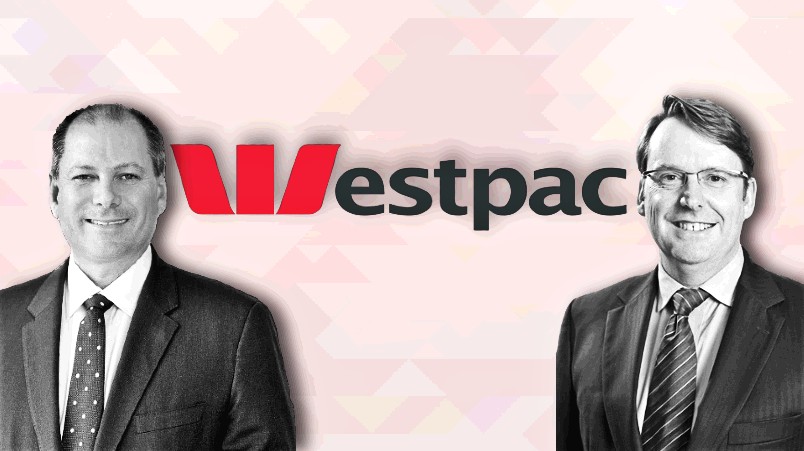Westpac to cut tech stack by two thirds amid $4bn overhaul, CFO sounds warning for vendors mulling price hikes

$4bn hit: Huge investments in technology but a big cut to the total technology stack incoming, per Westpac CEO Peter King (left) and CFO Michael Rowland.
Westpac is plotting a $4bn overhaul of its business in the name of customer experience, planning to entirely rebuild its back-end. Customer systems and data analytics will get a share of spoils as the bank shifts spending away from regulatory and risk and sprints to deliver an experience – and cost-base – that bests its peers. Yet despite all the extra money going into tech, the end result will be a vastly reduced architecture with Westpac culling tech components from 180 to just 60 systems. CFO Michael Rowland gave tech vendors thinking of hiking prices something to consider.
What you need to know:
- Westpac is undertaking a massive technology stack consolidation to rein-in supplier costs that are running ahead of inflation.
- The tech stack components (all tech, not just marketing) will be cut from 180 to to just 60 in a bid to "radically simplify" the bank in a way that puts the customer experience at the heart of Westpac operations, per CEO Peter King.
- Analysts questioned the bank's characterisation of the tech spending as "modest" saying it amounts to $4bn over four years. King admitted they are not wrong: "I agree this is a massive commitment for this organisation ... But we have to do it."
- The bank's digital transformation is already registering some wins with its app named best in class by Forrester following a two-year overhaul and its net promoter score (NPS) now the second-best in the sector. But its business banking NPS remains under water.
This is a massive commitment for this organisation. It is a big goal here. But we have to do it so we're a simpler organisation for so many reasons – customer service, risk management, cost. And as the world gets more complex in terms of its requirements, we need to simplify.
Westpac will spend close to $4bn over the next four years to radically simplify the bank and rebuild its back-end in a bid to overhaul customer experience and curb spiralling vendor costs.
CEO Peter King outlined the plan to financial analysts in its end-of-year earnings call. "There are four strategic pillars – customer, easy, expert, and advocate," according to King. "Ultimately success will be measured on growth in key markets and improving returns."
A huge technology transformation underpins the changes, but King underlined that the bank's 13 million customers sit at the heart of the strategy. That may seem facile but the reality is that banking has often been more focused on its own channels than on customer outcomes.
"They (customers) are at the heart of what we do. We value the whole of customer relationship and work hard to anticipate their needs, including through delivering personalised experiences, offers, and insights."
He said Westpac was focused on making banking easier, intuitive, and digital.
"This next phase is about radically simplifying the bank. For this to be successful, it's fundamental that we accelerate the simplification of processes and technology."
Shrink the stack
The scope of the transformation is profound, with the bank looking to shrink its tech stack by two-thirds – that's across all tech, not just marketing. King indicated there will be much more money flowing into customer-facing technology as cash is diverted from regulatory and risk systems, which have taken the lion's share of investment in recent years following the Royal Commission. He said work on the technology overhaul was already in progress, but will now move at pace.
"Over the past three years, we've progressed the foundational elements. More than 70 per cent of our infrastructure is now evergreen, meaning it's current and available to be built on," said King. "The focus from here is accelerating the simplification of product, platforms, and enterprise. And we'll start by reducing customer masses and modernising payments."
According to King, the bank's current tech "isn't older or less capable than peers, we just have too much of it". That's leading to spiralling technology costs, according to CFO Michael Rowland who told analysts that third party vendor costs are running "well ahead" of inflation.
Hence planning to take out two thirds of the tech stack.
"Cutting our technology components from around 180 down to around 60 will improve our speed to market make us more efficient on costs, and reduce operational risk," said King. "This is a big agenda for the company over the next four years. A period of sustained investment is required to support this strategy. And we believe that this can be achieved with a relatively modest increase in the investment envelope to approximately $2 billion per annum."
The money men however took issue with King characterising this as a modest increase.
According to analysts from Barrenjoey, the plan actually amounts to a massive turnaround strategy in the order of an extra billion a year in order to "rebuild the back-end of the bank", something King ultimately conceded.
"This is a massive commitment for this organisation. It is a big goal here. But we have to do it so we're a simpler organisation for so many reasons – customer service, risk management, costs. And as the world gets more complex in terms of its requirements, we need to simplify ... we see this as a 'must do'," said King.
"Technology simplification is a significant undertaking. It's part of our plan to improve service to customers, grow our business, and deliver a cost-to-income ratio close to peers, " he added.
Consumer pressures bite
King also addressed the issue of how customers are faring in a difficult economic climate.
"Consumers are being squeezed by cost of living pressures, many, many have no choice but to adjust their spending. While there has been an increase in hardship, the vast majority of consumers have displayed resilience."
He said the resulting pressure is washing through to businesses.
"For business, the slowdown in growth and higher costs is affecting demand and profitability. And we have seen a small rise in stress across business customers, although at this stage, it's been isolated."
Westpac, as King underlined, is clearly not immune from those cost rises. He headed off concern that the bank was now overspending on tech as a result of underinvestment by underlining that the capital would be more of a balloon squeeze in terms of resource allocation.
"In the five years to FY19, we invested approximately $1.3bn per annum. That increased to around $1.9bn in the last four years, with almost two-thirds allocated to risk and regulation. And our intent is to redirect from risk and regulation spend to growth and productivity," said King. "Customer experience is obviously the key driver. And the simplification will be jointly led by both the business and technology."
Digital overhaul template
After falling behind its peers digitally, the bank has begun to walk the talk on CX in recent years, significantly overhauling its capabilities in tandem with a concerted first party data push. Over the last two years, it has totally rebuilt its app, which was last week recognised by Forrester as the best banking app in Australia.
King nodded to the app rebuild and broader digital overhaul as a template for its now system-wide approach. "Technology underpins the customer offer. And the consolidation of infrastructure has resulted in significant improvement in system stability resilience ... it has created the foundation to accelerate our technology simplification, " he said.
The sprint to catch-up digitally with the likes of Commbank is paying dividend: the bank is scoring goals with retail consumers as evidenced by net promoter scores (NPS) for the app now moving into second place amongst its big bank peers. However, King acknowledged its business banking services still have plenty of room for improvement.
"If you look at the NPS or the service metrics in business, they're pretty low. They're negative in an absolute sense, and probably close to third, but they're not where we want them to be," said King. "So the first thing is to improve service. We've just rolled out a new provider of NPS, which is providing much more information at a product and experience level and geographic level, which is allowing us to link data between what we see internally and what the customer is saying."
Who said the c-suite didn't understand marketing metrics?



